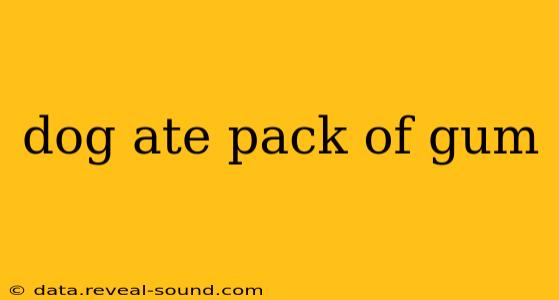Discovering your dog has devoured a pack of chewing gum can be a truly alarming experience. The potential dangers depend heavily on the type of gum and the amount ingested, making swift action crucial. This guide will help you understand the risks and outline the necessary steps to take if your furry friend has indulged in a forbidden treat.
What's in Gum That's Dangerous for Dogs?
The primary concern with dogs eating gum is xylitol. This artificial sweetener, commonly found in sugar-free gum, is incredibly toxic to canines. Even small amounts can cause a dramatic drop in blood sugar (hypoglycemia), leading to weakness, seizures, and even liver failure. Other ingredients, while less immediately dangerous, can also cause issues. The artificial colors and flavors can lead to upset stomachs, while the gum base itself can cause intestinal blockages, especially if swallowed in large quantities.
My Dog Ate Sugar-Free Gum: How Serious Is It?
The severity depends entirely on the amount of xylitol ingested and your dog's size. A small dog consuming a significant quantity of xylitol-containing gum faces a much greater risk than a large dog eating a single piece. Symptoms of xylitol poisoning can appear quickly, within 30 minutes to 12 hours, and include:
- Weakness or lethargy
- Vomiting
- Tremors or seizures
- Loss of coordination
- Difficulty breathing
If you suspect xylitol poisoning, immediate veterinary attention is absolutely vital. Don't wait for symptoms to develop; act quickly.
What if My Dog Ate Regular Gum?
While regular gum doesn't contain xylitol, it can still cause problems. The large amounts of sugar can lead to:
- Pancreatitis: Inflammation of the pancreas, a serious condition.
- Gastrointestinal upset: Vomiting, diarrhea, and abdominal pain.
- Dental issues: The sticky residue can contribute to plaque buildup and tooth decay.
Monitor your dog closely for signs of digestive upset. If vomiting or diarrhea is severe or persistent, consult your veterinarian.
How Much Gum Did My Dog Eat? Should I Induce Vomiting?
Determining the precise amount of gum your dog consumed is crucial. Check the packaging for the number of pieces and try to estimate how many are missing. Do not attempt to induce vomiting at home unless specifically instructed by a veterinarian. Improperly induced vomiting can be more harmful than the gum itself.
What Should I Do If My Dog Ate Gum?
- Identify the type of gum: Was it sugar-free (xylitol-containing)? How many pieces were consumed?
- Check your dog for symptoms: Is your dog exhibiting any of the signs listed above?
- Contact your veterinarian or an animal poison control center immediately. They can provide guidance based on the specific circumstances.
- Gather information: Have the gum packaging readily available to provide to the vet. Note the time of ingestion and any observed symptoms.
- Follow your veterinarian's instructions: They may recommend bringing your dog in for examination and treatment.
Can I Prevent My Dog From Eating Gum in the Future?
- Keep gum out of reach: Store gum in cabinets or other secure locations.
- Train your dog: Work on "leave it" and "drop it" commands to help prevent future incidents.
- Supervise your dog: Closely monitor your dog, particularly when guests are present who may drop or leave gum within reach.
Remember, prevention is always the best medicine. By taking proactive measures and knowing what to do in an emergency, you can help protect your beloved canine companion from the dangers of ingested gum. If you are ever unsure, err on the side of caution and contact your vet.
